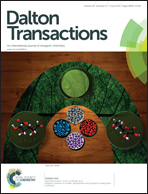Stable and color tunable emission properties based on non-cyclometalated gold(iii) complexes†
Abstract
Stable and emission tunable non-cyclometalated gold(III) triaryl complexes of the type [(L)Au(C6F5)3] [L = 2-(2,4-difluorophenylpyridine) (1), 4-phenylpyridine (2), 2-phenylpyridine (3), 2-phenylisoquinoline (4), 2-thienylpyridine (5)] were synthesized starting from a common precursor complex [(THT)Au(C6F5)3] [THT = tetrahydrothiophene] in good to modest yields. Extensive characterization of the complexes by various nuclear magnetic resonance spectroscopy techniques and elemental analysis further corroborated the single-crystal X-ray diffraction studies. The complexes displayed room temperature phosphorescence in the neat solid and in 2-MeTHF at 77 K. Detailed photophysical investigations of the complexes in the neat solid and at 77 K revealed the successful tuning of the emission maxima with modest quantum yields across the visible part of the electromagnetic spectrum depending on the electronic properties of the heterocyclic ligands. DFT (Density Functional Theory) and TDDFT (Time Dependent Density Functional Theory) calculations were performed to discern the composition of the excited state as well as confirm the obtained relative emission energies upon substitution with electronically different ligands. The obtained diverse emissive behavior of the complexes combined with the ease of synthesis illustrate the generality and applicability of the design approach to obtain emissive gold(III) complexes devoid of cyclometalation.


 Please wait while we load your content...
Please wait while we load your content...